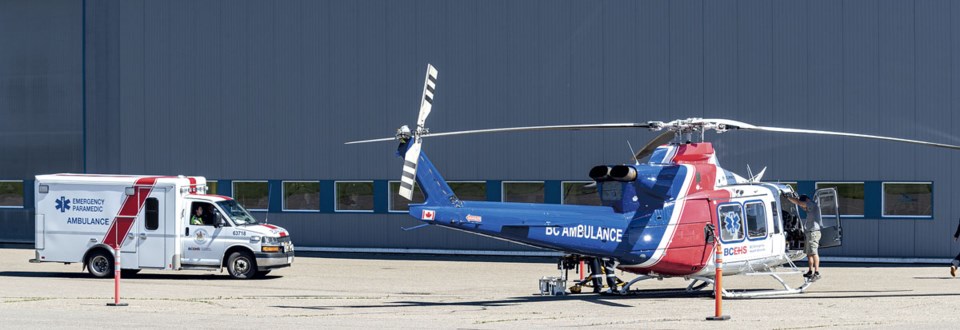We’re glad to see the province moving forward with the much-needed expansion and modernization of Prince George’s only hospital. It’s been a long time coming. But we had a question for Health Minister Adrian Dix when he was here last week: “Why is there no helipad in the plan?”
Dix told us why, but the answer wasn’t good enough.
We live close to some of the most rugged land in the country. We’re proud of our mountains, valleys, rivers and lakes, but we respect and fear them, too. People live, work and play in these challenging environments, and unfortunately, things sometimes go wrong. From sick residents in isolated communities to lost hikers to injured firefighters to workers hurt in remote camps, there will always be a need for medevacs.
When that happens in a place without easy road or water access, there’s only one way to get help to the injured: B.C. Emergency Health Services helicopters and planes. And Prince George is where they bring them.
Air ambulances serve two primary purposes, both of which matter in Prince George, perhaps more so than in other communities further south.
First, they are used to get to people in danger and transport them to a hospital. In some cases this means flying to a small town a couple of hours’ drive away, but in others it could mean heading into the remote areas we mentioned earlier, places land ambulances can’t reach.
The other function involves getting people from Prince George to larger centres with more advanced medical care options. In these cases, it’s quite often an emergency, and time is of the essence.
Unfortunately, for all the good our air ambulances (and their specially trained crews) can do, there’s a weak link. Our hospital has no helipad. Prince George, in fact, is the only major B.C. city that does not have a helicopter landing pad at its hospital.
As things work now, air ambulances land at the Prince George International Airport, with patients transferred to or from UHNBC – 14.6 kilometres away - by land ambulance.
The argument can be made that unlike other, larger centres, YXS is a short drive away, just outside the city, and traffic here isn’t a major issue. An ambulance can meet the chopper there and be at UHNBC in about 20 minutes (on a good day).
But that’s not good enough. Mayor Simon Yu noted this in January when he drew a connection between industrial growth in the north and an increased need for faster, more efficient medevac services. Resource-based jobs are dangerous, after all.
We have an excellent hospital. With this latest announcement from the province, it’s about to become even better as the population both ages and grows. But without a helipad … “This hospital is the regional trauma centre and how do we tie in with our city and region’s 911 program when this helipad is not there?” Yu said at the time. “It doesn’t make sense.”
There's no drive to add it at the local level, either. Earlier this year, we heard this from Steve Raper, vice-president of communications and public affairs for the Northern Health Authority: “It’s not part of this current business case for the tower at this point," he said, adding that the concept wasn't off the table and would be explored at some point.
There must be a helipad added to the mix, and soon. On the roof would be ideal, but there are other options that should be considered.
Many hospitals in Canada have helipads at ground level. That may be where the province is going with this. Dix told The Citizen that the lack of a helipad at this stage of the plan doesn’t mean there will never be one, just that the province is considering plans that won’t require the pad to be built on the roof.
“We are looking at all the options there, which don’t necessarily include a rooftop option,” Dix told us. “We would hope to formulate them soon. There are other options to bring a helicopter to the hospital … We’re focused on how to deliver better services and how to bring helicopter service closer and that just does not necessarily involve a rooftop approach.”
This is somewhat encouraging, at least. However, let’s not forget how slow this hospital expansion process has been. It will be years before the expansion is complete. We have to have a helipad sooner. Prince George will soon have a new Leonardo AW 169 twin-engine BC Emergency Health Services helicopter; it should be based where it’s needed, not at the airport.
Let’s hold Dix to what he told us and continue to remind the province just how much Prince George needs this vital service, and how important it is that we shave that last 20 minutes off the most difficult journey some people will ever have to make.



